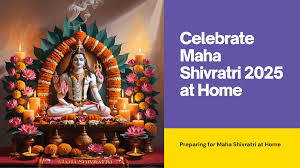
Maha Shivratri is one of the most significant Hindu festivals dedicated to Lord Shiva. Observed annually, it falls on the 14th night of the waning moon in the Hindu month of Phalguna (February-March). Devotees fast, pray, and perform rituals to seek Lord Shiva’s blessings for health, prosperity, and spiritual awakening. As Maha Shivratri 2025 approaches, many people prefer to celebrate this auspicious occasion at home with devotion and purity. Performing the Maha Shivaratri pooja at home allows families to connect with spirituality while following traditional rituals.
Where is Maha Shivratri Celebrated?
Maha Shivratri is celebrated with great enthusiasm across India and in various parts of the world where Hindu communities reside. Some of the major locations known for grand celebrations include:
- Varanasi, Uttar Pradesh – The city of Lord Shiva witnesses massive gatherings and Ganga Aarti.
- Ujjain, Madhya Pradesh – Mahakaleshwar Temple is a major pilgrimage site.
- Kedarnath, Uttarakhand – One of the twelve Jyotirlingas, Kedarnath is a sacred place to honor Shiva.
- Nepal – Pashupatinath Temple – A significant Shiva temple where grand Maha Shivratri celebrations take place.
Even if you cannot visit these sacred places, you can still celebrate Maha Shivratri at home by following the correct rituals and customs.
Advantages of Celebrating Maha Shivratri at Home
Observing Maha Shivratri at home has numerous spiritual and personal benefits, including:
- Spiritual Purification – Chanting mantras and performing rituals cleanse the mind and soul.
- Family Bonding – A great opportunity to engage in prayers and devotion together.
- Peace and Positivity – Creating a sacred space at home brings tranquility and divine energy.
- Convenience and Comfort – No need to travel; you can worship in a peaceful environment.
- Customized Rituals – You can perform the pooja as per your family’s traditions and preferences.
Steps to Perform Maha Shivaratri Pooja at Home
- Preparations for the Pooja
- Wake up early and take a holy bath.
- Clean your home and create a sacred space for the pooja.
- Place a Shiva Lingam or a picture of Lord Shiva on an altar.
- Gather all essential pooja items like milk, water, bel leaves, fruits, and incense sticks.
- Fasting and Meditation
- Devotees observe a fast on Maha Shivratri, consuming only fruits, milk, and water.
- Meditation and chanting “Om Namah Shivaya” throughout the day enhances spiritual growth.
- Abhishekam (Holy Bath of Shiva Lingam)
- Perform Abhishekam using milk, honey, curd, ghee, and Ganga Jal.
- Offer bilva (bel) leaves, which are considered sacred for Lord Shiva.
- Light a diya (lamp) and incense sticks to purify the surroundings.
- Chanting and Mantras
- Recite Maha Mrityunjaya Mantra for health and longevity.
- Read or listen to Shiva Purana to understand the significance of this day.
- Sing devotional bhajans and kirtans in praise of Lord Shiva.
- Night-long Vigil (Jagran)
- Stay awake throughout the night, engaging in prayer, meditation, and chanting.
- Some devotees visit nearby temples to participate in community prayers.
- Concluding the Pooja
- Break your fast the next morning after offering food (prasad) to Lord Shiva.
- Share prasad with family members and seek blessings for prosperity.
Types of Maha Shivratri Pooja at Home
There are various ways to perform the Maha Shivaratri pooja at home, depending on devotion and family traditions:
- Simple Pooja
- Ideal for beginners.
- Consists of offering flowers, lighting a diya, and chanting mantras.
- Traditional Shivratri Pooja
- Includes Abhishekam with five sacred elements (Panchamrit: milk, honey, curd, ghee, and sugar).
- Recitation of Shiva Chalisa and Maha Mrityunjaya Mantra.
- Four Prahar Pooja
- Divides the night into four phases, with each phase dedicated to different offerings:
- 1st Prahar: Water Abhishekam
- 2nd Prahar: Milk Abhishekam
- 3rd Prahar: Honey Abhishekam
- 4th Prahar: Panchamrit Abhishekam
- Linga Archana Pooja
- Involves offering bel leaves, flowers, and sacred ash to a Shiva Lingam.
- Mantra Japa Pooja
- Focuses on continuous chanting of Om Namah Shivaya and meditation.
Conclusion
Celebrating Maha Shivratri 2025 at home is a deeply fulfilling spiritual experience. By following the traditional rituals of Maha Shivaratri pooja at home, devotees can seek Lord Shiva’s divine blessings for health, happiness, and prosperity. Whether through fasting, meditation, or chanting mantras, this sacred festival helps in achieving spiritual growth and inner peace. Preparing in advance and involving family members can make the celebration more meaningful and blissful.
Frequently Asked Questions
- Can I do Maha Shivratri pooja at home without a Shiva Lingam?
Yes, you can worship Lord Shiva by offering flowers, lighting a lamp, and chanting mantras in front of His image or idol.
- What food can I eat during Maha Shivratri fasting?
Devotees usually consume fruits, milk, dry fruits, and specific vrat-friendly foods like sabudana khichdi.
- What time should I perform the pooja at home?
The pooja is best performed during Nishita Kaal (midnight), but devotees can also conduct prayers in the evening.
- Can pregnant women observe the Maha Shivratri fast?
Pregnant women can follow a modified fast by consuming nutritious foods and avoiding strict fasting.
- Why is night vigil (Jagran) important on Maha Shivratri?
Staying awake throughout the night symbolizes overcoming darkness and ignorance, leading to spiritual enlightenment.
By following these rituals and guidelines, you can celebrate Maha Shivratri at home in a spiritually enriching way. May Lord Shiva bless you with health, wealth, and happiness on this auspicious occasion of Maha Shivaratri 2025!




Leave a Reply